Effects of Dextran on the Gel Properties of Faba Bean Protein Isolates Prepared Using Different Processes
Abstract
:1. Introduction
2. Results and Discussion
2.1. Characterization of FPIs
2.1.1. Composition and Solubility
2.1.2. Particle Size
2.2. Characterization of Crude DX
2.3. Preparation and Characterization of GDL-Induced FPI Gels
2.3.1. Preparation of GDL-Induced FPI Gels
2.3.2. WHC and Hardness
2.3.3. Dynamic Rheological Analysis
2.3.4. CLSM Observation
2.3.5. Chemical Interactions and Free Sulfhydryl Groups
3. Conclusions
4. Materials and Methods
4.1. Materials
4.2. FPI Preparation
4.2.1. Compositional Analysis
4.2.2. Protein Solubility and Turbidity Measurement
4.2.3. SDS-PAGE
4.2.4. Particle Size Distribution
4.3. Crude DX Preparation
4.4. Effect of DX on FPI Gel Characteristics
4.4.1. Preparation of GDL-Induced Gels
4.4.2. WHC Analysis
4.4.3. Hardness Analysis
4.4.4. Dynamic Oscillatory Rheology
4.4.5. CLSM
4.4.6. Analysis of Chemical Interactions in the Gel
4.4.7. Measurement of Free SH– Content
4.5. Statistical Analysis
Author Contributions
Funding
Institutional Review Board Statement
Informed Consent Statement
Data Availability Statement
Conflicts of Interest
Appendix
| Concentration (%) | WHC (%) |
|---|---|
| 0 | 61.23 ± 1.26 d |
| 0.25 | 62.79 ± 0.48 d |
| 0.5 | 66.45 ± 0.51 c |
| 1 | 70.15 ± 0.67 b |
| 2 | 72.33 ± 2.27 a |
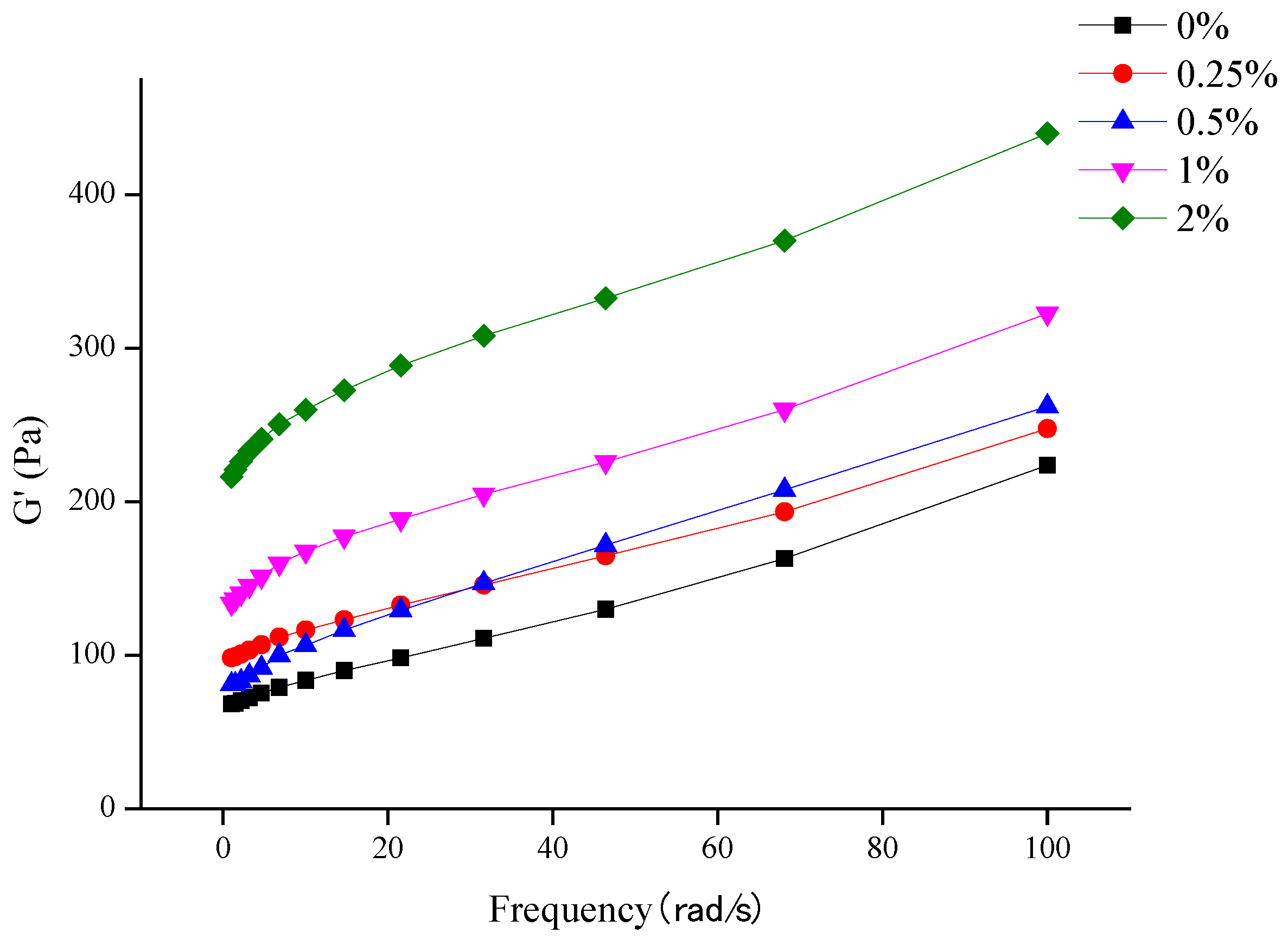
References
- Schmelter, L.; Rohm, H.; Struck, S. Gluten-Free Bakery Products: Cookies Made from Different Vicia Faba Bean Varieties. Futur. Foods 2021, 4, 100038. [Google Scholar] [CrossRef]
- Gangola, M.P.; Ramadoss, B.R.; Jaiswal, S.; Chan, C.; Mollard, R.; Fabek, H.; Tulbek, M.; Jones, P.; Sanchez-Hernandez, D.; Anderson, G.H.; et al. Faba Bean Meal, Starch or Protein Fortification of Durum Wheat Pasta Differentially Influence Noodle Composition, Starch Structure and in Vitro Digestibility. Food Chem. 2021, 349, 129167. [Google Scholar] [CrossRef]
- Hewage, A.; Olatunde, O.O.; Nimalaratne, C.; Malalgoda, M.; Aluko, R.E.; Bandara, N. Novel Extraction Technologies for Developing Plant Protein Ingredients with Improved Functionality. Trends Food Sci. Technol. 2022, 129, 492–511. [Google Scholar] [CrossRef]
- da Silva, A.M.M.; Almeida, F.S.; da Silva, M.F.; Goldbeck, R.; Sato, A.C.K. How Do PH and Temperature Influence Extraction Yield, Physicochemical, Functional, and Rheological Characteristics of Brewer Spent Grain Protein Concentrates? Food Bioprod. Process. 2023, 139, 34–45. [Google Scholar] [CrossRef]
- Johansson, M.; Johansson, D.; Ström, A.; Rydén, J.; Nilsson, K.; Karlsson, J.; Moriana, R.; Langton, M. Effect of Starch and Fibre on Faba Bean Protein Gel Characteristics. Food Hydrocoll. 2022, 131, 107741. [Google Scholar] [CrossRef]
- Monteiro, S.R.; Rebelo, S.; da Cruz e Silva, O.A.B.; Lopes-da-Silva, J.A. The Influence of Galactomannans with Different Amount of Galactose Side Chains on the Gelation of Soy Proteins at Neutral PH. Food Hydrocoll. 2013, 33, 349–360. [Google Scholar] [CrossRef]
- Ma, K.K.; Greis, M.; Lu, J.; Nolden, A.A.; McClements, D.J.; Kinchla, A.J. Functional Performance of Plant Proteins. Foods 2022, 11, 594. [Google Scholar] [CrossRef] [PubMed]
- Verfaillie, D.; Janssen, F.; Van Royen, G.; Wouters, A.G.B. A Systematic Study of the Impact of the Isoelectric Precipitation Process on the Physical Properties and Protein Composition of Soy Protein Isolates. Food Res. Int. 2023, 163, 112177. [Google Scholar] [CrossRef] [PubMed]
- Lopes-da-Silva, J.A.; Monteiro, S.R. Gelling and Emulsifying Properties of Soy Protein Hydrolysates in the Presence of a Neutral Polysaccharide. Food Chem. 2019, 294, 216–223. [Google Scholar] [CrossRef] [PubMed]
- Tseng, Y.C.; Xiong, Y.L. Effect of Inulin on the Rheological Properties of Silken Tofu Coagulated with Glucono-δ-Lactone. J. Food Eng. 2009, 90, 511–516. [Google Scholar] [CrossRef]
- Dille, M.J.; Knutsen, S.H.; Draget, K.I. Gels and Gelled Emulsions Prepared by Acid-Induced Gelation of Mixtures of Faba Bean (Vicia Faba) Protein Concentrate and λ-Carrageenan. Appl. Food Res. 2022, 2, 100174. [Google Scholar] [CrossRef]
- Chen, Z.; Tian, Y.; Zhang, W.; Guang, C.; Meng, X.; Mu, W. Novel Dextransucrase Gtf-DSM, Highly Similar in Sequence to Reuteransucrase GtfO, Displays Unique Product Specificity. J. Agric. Food Chem. 2019, 67, 12806–12815. [Google Scholar] [CrossRef] [PubMed]
- Xu, Y.; Pitkänen, L.; Maina, N.H.; Coda, R.; Katina, K.; Tenkanen, M. Interactions between Fava Bean Protein and Dextrans Produced by Leuconostoc Pseudomesenteroides DSM 20193 and Weissella Cibaria Sj 1b. Carbohydr. Polym. 2018, 190, 315–323. [Google Scholar] [CrossRef] [PubMed]
- Dong, H.; Li, Y.; Jia, C.; Zhang, B.; Niu, M.; Zhao, S.; Xu, Y. Mechanism behind the Rheological Property Improvement of Fava Bean Protein by the Presence of Dextran. Food Hydrocoll. 2022, 133, 107907. [Google Scholar] [CrossRef]
- Vogelsang-O’Dwyer, M.; Petersen, I.L.; Joehnke, M.S.; Sørensen, J.C.; Bez, J.; Detzel, A.; Busch, M.; Krueger, M.; O’Mahony, J.A.; Arendt, E.K.; et al. Comparison of Faba Bean Protein Ingredients Produced Using Dry Fractionation and Isoelectric Precipitation: Techno-Functional, Nutritional and Environmental Performance. Foods 2020, 9, 322. [Google Scholar] [CrossRef] [PubMed]
- Yang, X.; Ke, C.; Li, L. Physicochemical, Rheological and Digestive Characteristics of Soy Protein Isolate Gel Induced by Lactic Acid Bacteria. J. Food Eng. 2021, 292, 110243. [Google Scholar] [CrossRef]
- Keivaninahr, F.; Gadkari, P.; Zoroufchi Benis, K.; Tulbek, M.; Ghosh, S. Prediction of Emulsification Behaviour of Pea and Faba Bean Protein Concentrates and Isolates from Structure-Functionality Analysis. RSC Adv. 2021, 11, 12117–12135. [Google Scholar] [CrossRef] [PubMed]
- Bühler, J.M.; Dekkers, B.L.; Bruins, M.E.; Van Der Goot, A.J. Modifying Faba Bean Protein Concentrate Using Dry Heat to Increase Water Holding Capacity. Foods 2020, 9, 1077. [Google Scholar] [CrossRef]
- Warsame, A.O.; O’Sullivan, D.M.; Tosi, P. Seed Storage Proteins of Faba Bean (Vicia Faba L): Current Status and Prospects for Genetic Improvement. J. Agric. Food Chem. 2018, 66, 12617–12626. [Google Scholar] [CrossRef]
- Chao, D.; Aluko, R.E. Modification of the Structural, Emulsifying, and Foaming Properties of an Isolated Pea Protein by Thermal Pretreatment. CYTA-J. Food 2018, 16, 357–366. [Google Scholar] [CrossRef]
- Shen, X.; Zhao, C.; Guo, M. Effects of High Intensity Ultrasound on Acid-Induced Gelation Properties of Whey Protein Gel. Ultrason. Sonochem. 2017, 39, 810–815. [Google Scholar] [CrossRef]
- Hu, H.; Cheung, I.W.Y.; Pan, S.; Li-Chan, E.C.Y. Effect of High Intensity Ultrasound on Physicochemical and Functional Properties of Aggregated Soybean β-Conglycinin and Glycinin. Food Hydrocoll. 2015, 45, 102–110. [Google Scholar] [CrossRef]
- Yang, Y.; Peng, Q.; Guo, Y.; Han, Y.; Xiao, H.; Zhou, Z. Isolation and Characterization of Dextran Produced by Leuconostoc Citreum NM105 from Manchurian Sauerkraut. Carbohydr. Polym. 2015, 133, 365–372. [Google Scholar] [CrossRef]
- Li, X.; Liu, Y.; Li, N.; Xie, D.; Yu, J.; Wang, F.; Wang, J. Studies of Phase Separation in Soluble Rice Protein/Different Polysaccharides Mixed Systems. LWT-Food Sci. Technol. 2016, 65, 676–682. [Google Scholar] [CrossRef]
- Mende, S.; Peter, M.; Bartels, K.; Dong, T.; Rohm, H.; Jaros, D. Concentration Dependent Effects of Dextran on the Physical Properties of Acid Milk Gels. Carbohydr. Polym. 2013, 98, 1389–1396. [Google Scholar] [CrossRef] [PubMed]
- Patole, S.; Cheng, L.; Yang, Z. Impact of Incorporations of Various Polysaccharides on Rheological and Microstructural Characteristics of Heat-Induced Quinoa Protein Isolate Gels. Food Biophys. 2022, 17, 314–323. [Google Scholar] [CrossRef]
- Zhuang, X.; Jiang, X.; Zhou, H.; Chen, Y.; Zhao, Y.; Yang, H.; Zhou, G. Insight into the Mechanism of Physicochemical Influence by Three Polysaccharides on Myofibrillar Protein Gelation. Carbohydr. Polym. 2020, 229, 115449. [Google Scholar] [CrossRef] [PubMed]
- Li, J.; Wu, M.; Wang, Y.; Li, K.; Du, J.; Bai, Y. Effect of PH-Shifting Treatment on Structural and Heat Induced Gel Properties of Peanut Protein Isolate. Food Chem. 2020, 325, 126921. [Google Scholar] [CrossRef] [PubMed]
- Priyashantha, H.; Quintáns, A.P.; Baixauli, R.; Vidanarachchi, J.K. Type of Starter Culture Influences on Structural and Sensorial Properties of Low Protein Fermented Gels. J. Texture Stud. 2019, 50, 482–492. [Google Scholar] [CrossRef] [PubMed]
- Jiang, Z.Q.; Wang, J.; Stoddard, F.; Salovaara, H.; Sontag-Strohm, T. Preparation and Characterization of Emulsion Gels from Whole Faba Bean Flour. Foods 2020, 9, 755. [Google Scholar] [CrossRef] [PubMed]
- Cramp, G.L.; Kwanyuen, P.; Daubert, C.R. Molecular Interactions and Functionality of a Cold-Gelling Soy Protein Isolate. J. Food Sci. 2008, 73, 16–24. [Google Scholar] [CrossRef] [PubMed]
- Wang, X.; Yu, M.; Wang, Z.; Luo, K.; Adhikari, B.; Miao, S.; Liu, S. Modulation of Soy Protein Isolate Gel Properties by a Novel “Two-Step” Gelation Process: Effects of Pre-Aggregation with Different Divalent Sulfates. Food Chem. 2022, 394, 133515. [Google Scholar] [CrossRef] [PubMed]
- Shand, P.J.; Ya, H.; Pietrasik, Z.; Wanasundara, P.K.J.P.D. Physicochemical and Textural Properties of Heat-Induced Pea Protein Isolate Gels. Food Chem. 2007, 102, 1119–1130. [Google Scholar] [CrossRef]
- Lazaridou, A.; Vaikousi, H.; Biliaderis, C.G. Impact of Mixed-Linkage (1→3, 1→4) β-Glucans on Physical Properties of Acid-Set Skim Milk Gels. Int. Dairy J. 2008, 18, 312–322. [Google Scholar] [CrossRef]
- Klost, M.; Brzeski, C.; Drusch, S. Effect of Protein Aggregation on Rheological Properties of Pea Protein Gels. Food Hydrocoll. 2020, 108, 106036. [Google Scholar] [CrossRef]
- Çakir, E.; Foegeding, E.A. Combining Protein Micro-Phase Separation and Protein-Polysaccharide Segregative Phase Separation to Produce Gel Structures. Food Hydrocoll. 2011, 25, 1538–1546. [Google Scholar] [CrossRef]
- Zhao, H.; Li, W.; Qin, F.; Chen, J. Calcium Sulphate-Induced Soya Bean Protein Tofu-Type Gels: Influence of Denaturation and Particle Size. Int. J. Food Sci. Technol. 2016, 51, 731–741. [Google Scholar] [CrossRef]
- Tang, C.H.; Wang, X.Y.; Yang, X.Q.; Li, L. Formation of Soluble Aggregates from Insoluble Commercial Soy Protein Isolate by Means of Ultrasonic Treatment and Their Gelling Properties. J. Food Eng. 2009, 92, 432–437. [Google Scholar] [CrossRef]
- Li, C.; Chen, G.; Ran, C.X.; Liu, L.; Wang, S.; Xu, Y.; Tan, Y.; Kan, J. Adlay Starch-Gluten Composite Gel: Effects of Adlay Starch on Rheological and Structural Properties of Gluten Gel to Molecular and Physico-Chemical Characteristics. Food Chem. 2019, 289, 121–129. [Google Scholar] [CrossRef]
- Xu, Q.; Qi, B.; Han, L.; Wang, D.; Zhang, S.; Jiang, L.; Xie, F.; Li, Y. Study on the Gel Properties, Interactions, and PH Stability of Pea Protein Isolate Emulsion Gels as Influenced by Inulin. LWT 2021, 137, 110421. [Google Scholar] [CrossRef]
- Makri, E.A.; Papalamprou, E.M.; Doxastakis, G.I. Textural Properties of Legume Protein Isolate and Polysaccharide Gels Eleousa. J. Sci. Food Agric. 2006, 86, 1855–1862. [Google Scholar] [CrossRef]
- GB/T 5009.10-2003; Determination of Crude Fiber in Vegetable Foods. General Administration of Quality Supervision. Inspection and Quarantine of the People‘s Republic of China: Beijing, China, 2003.
- Huang, K.; Shi, J.; Li, M.; Sun, R.; Guan, W.; Cao, H.; Guan, X.; Zhang, Y. Intervention of Microwave Irradiation on Structure and Quality Characteristics of Quinoa Protein Aggregates. Food Hydrocoll. 2022, 130, 107677. [Google Scholar] [CrossRef]
- Brito-Oliveira, T.C.; Bispo, M.; Moraes, I.C.F.; Campanella, O.H.; Pinho, S.C. Stability of Curcumin Encapsulated in Solid Lipid Microparticles Incorporated in Cold-Set Emulsion Filled Gels of Soy Protein Isolate and Xanthan Gum. Food Res. Int. 2017, 102, 759–767. [Google Scholar] [CrossRef]
- Tang, H.; Chen, J.; Liu, B.; Wang, X.; Shi, Q.; Li, H. Rheological Properties of Dextran/Faba Bean Protein Composite Gel. Mod. Food Sci. Technol. 2022, 38, 69–76. [Google Scholar] [CrossRef]
- Gómez-Guillén, M.C.; Borderías, A.J.; Montero, P. Chemical Interactions of Nonmuscle Proteins in the Network of Sardine (Sardina Pilchardus) Muscle Gels. LWT-Food Sci. Technol. 1997, 30, 602–608. [Google Scholar] [CrossRef]
- Beveridge, T.; Tome, S.J.; Nakai, S. Determination of SH- and SS-Groups in Some Food Proteins Using Ellman’s Reagent. J. Food Sci. 1974, 39, 49–51. [Google Scholar] [CrossRef]
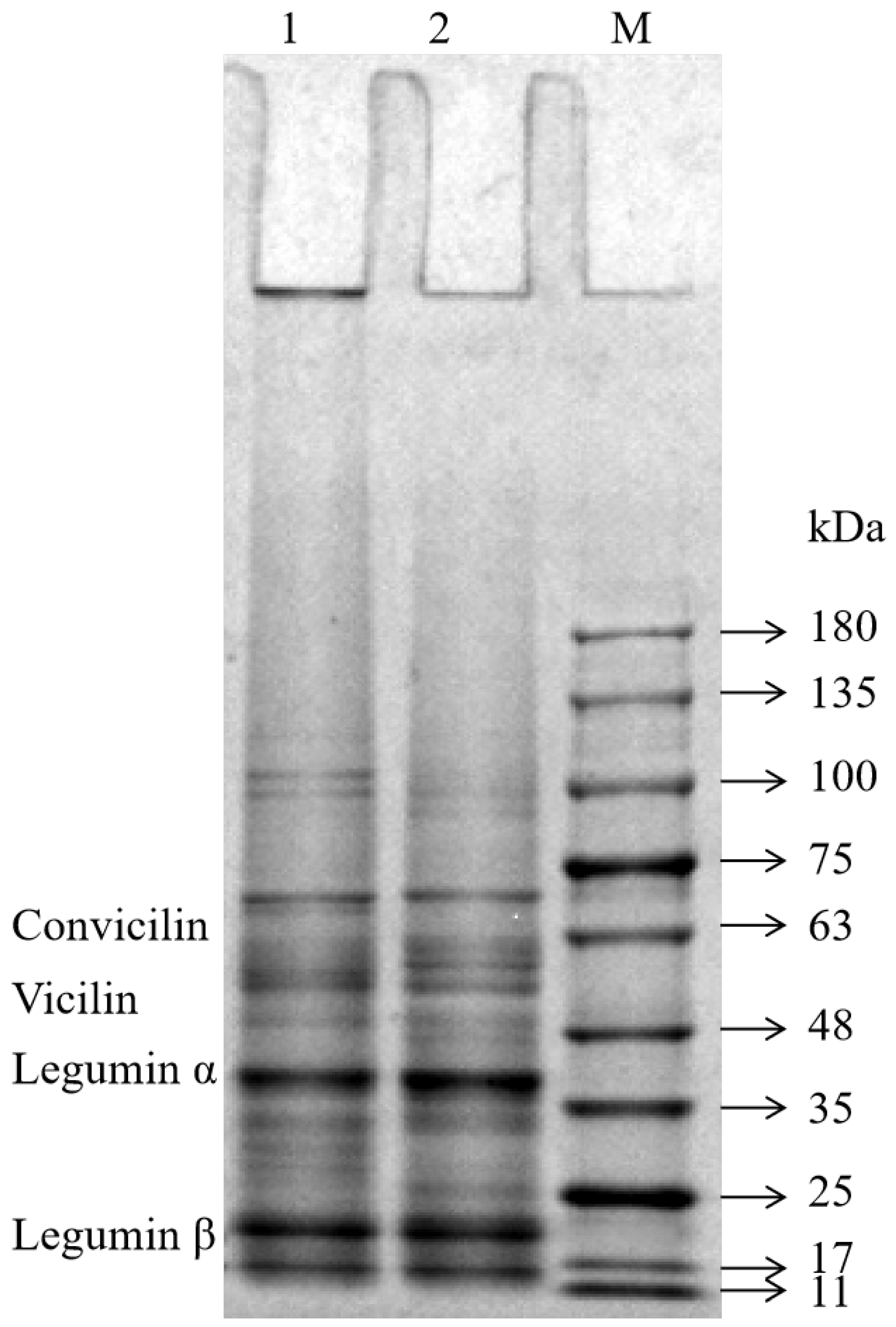
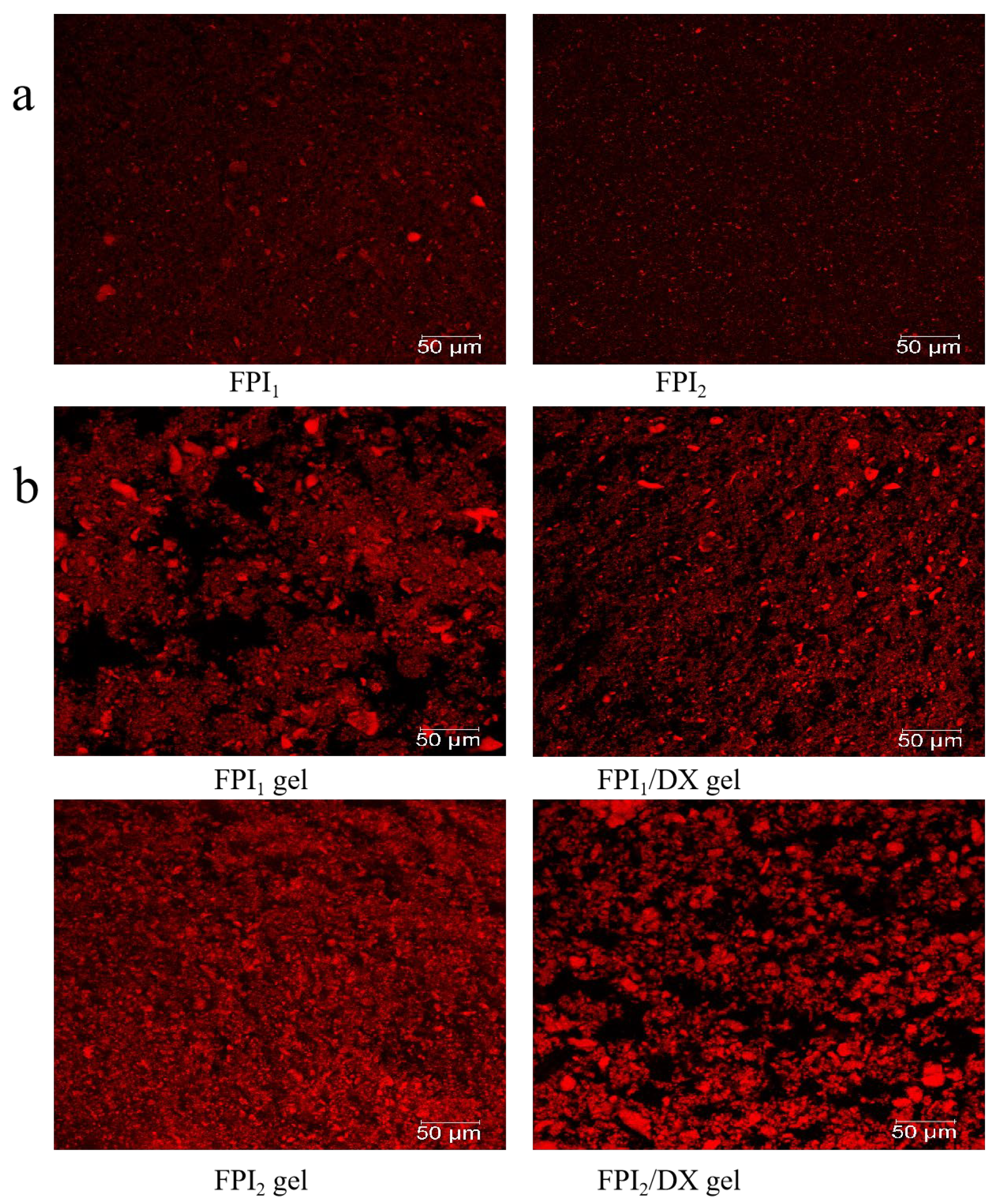
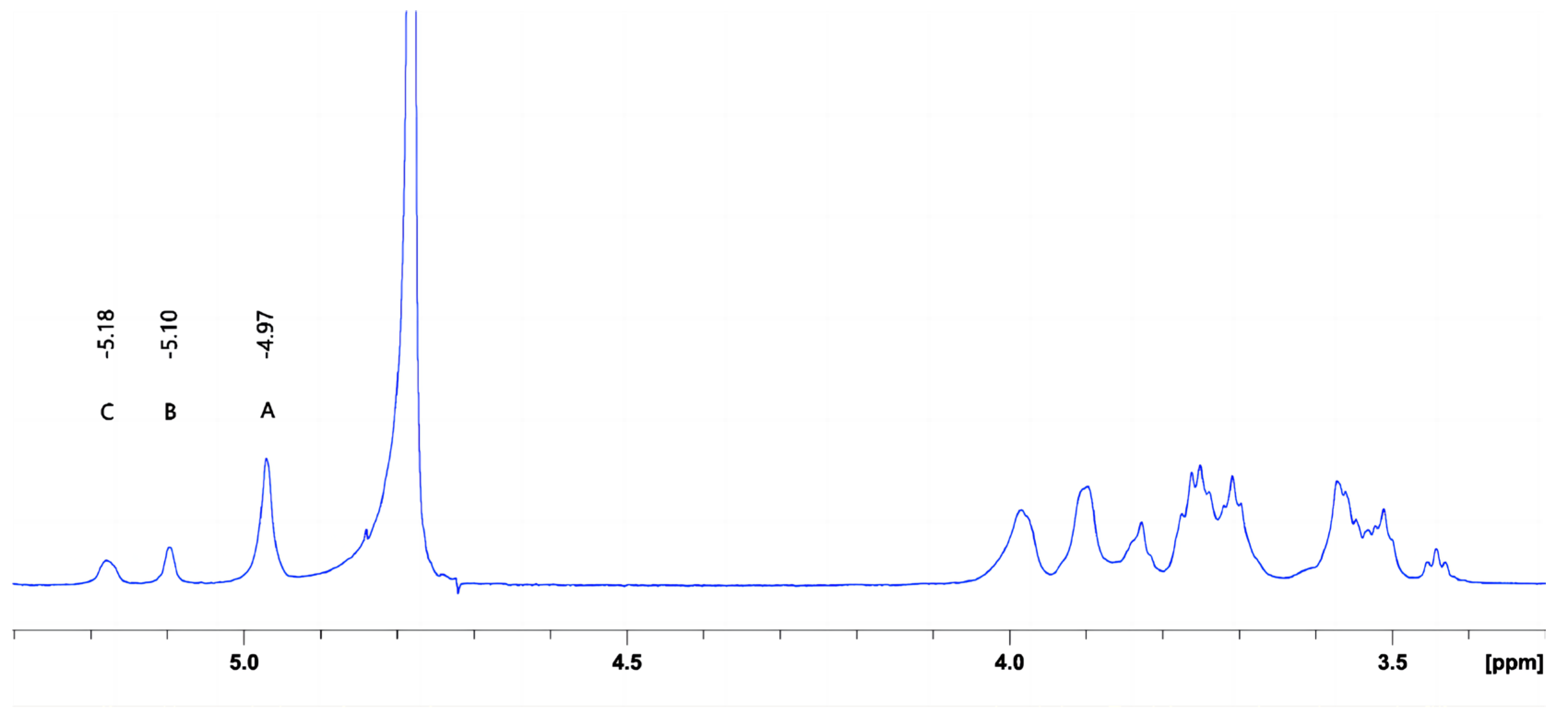
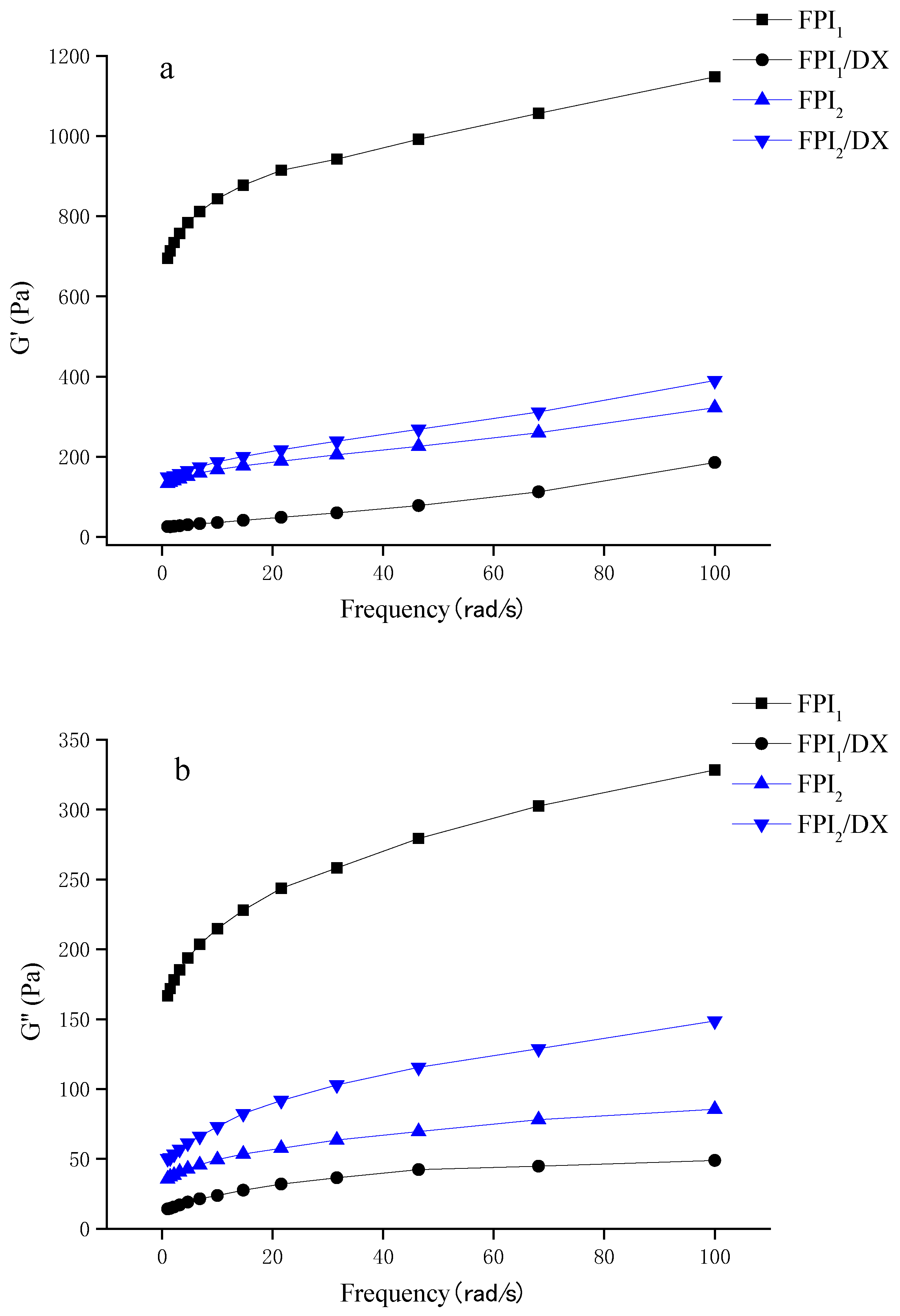
| Protein samples | Protein (%) | Starch (%) | Fat (%) | Ash (%) | Dietary fiber (%) | Moisture (%) | Solubility (%) | T (A600) |
|---|---|---|---|---|---|---|---|---|
| FPI1 | 80.70 | 2.60 | 7.60 | 3.80 | 0.60 | 6.42 | 17.29 | 0.77 |
| FPI2 | 77.00 | 2.60 | 6.40 | 5.20 | 0.20 | 8.32 | 66.53 | 0.39 |
| Protein Samples | D10 (μm) | D50 (μm) | D90 (μm) | D4,3 (μm) |
|---|---|---|---|---|
| FPI1 | 13.63 ± 0.04 a | 37.45 ± 0.19 a | 82.97 ± 0.49 a | 45.73 ± 0.23 a |
| FPI2 | 8.36 ± 0.04 b | 21.64 ± 0.05 b | 55.99 ± 0.11 b | 8.99 ± 0.17 b |
| DX Sample | Source Microorganism | Mw (g/mol) | Intrinsic Viscosity (cm3/g) | Constituent Glucopyranosyl Units | Distribution (%) |
|---|---|---|---|---|---|
| G26 | L. citreum G26 | 4.98 × 106 | 23.33 | (A) →6)-α-D-Glcp-(1→6)- | 68.56 |
| (B) α-D-Glcp-(1→2)- | 15.50 | ||||
| (C) →2,6)-α-D-Glcp-(1→6)- | 15.94 |
| Gel Samples | WHC (%) | Hardness (N) |
|---|---|---|
| FPI1 | 62.72 ± 0.54 c | 0.16 ± 0.0076 b |
| FPI1/DX | 68.09 ± 1.45 b | 0.11 ± 0.0040 c |
| FPI2 | 61.23 ± 1.26 c | 0.21 ± 0.0046 a |
| FPI2/DX | 72.33 ± 2.27 a | 0.18 ± 0.0220 b |
| Gel Samples | Intermolecular Interaction Forces | Free SH– (μmol/g) | |||
|---|---|---|---|---|---|
| Ionic Bonds (g/L) | Hydrogen Bonds (g/L) | Hydrophobic Interactions (g/L) | Disulfide Bonds (g/L) | ||
| FPI1 | 0.12 ± 0.00 cC | 0.07 ± 0.02 cC | 1.42 ± 0.03 cB | 4.70 ± 0.12 aA | 8.80 ± 0.20 d |
| FPI1/DX | 0.02 ± 0.00 dC | 0.13 ± 0.00 cC | 1.11 ± 0.03 cB | 2.87 ± 0.12 bA | 11.66 ± 0.21 c |
| FPI2 | 0.85 ± 0.02 aC | 2.2 ± 0.10 aB | 2.27 ± 0.09 bB | 2.99 ± 0.02 bA | 13.61 ± 0.13 b |
| FPI2/DX | 0.26 ± 0.05 bD | 1.2 ± 0.04 bC | 3.44 ± 0.16 aA | 2.88 ± 0.10 bB | 20.01 ± 0.12 a |
Disclaimer/Publisher’s Note: The statements, opinions and data contained in all publications are solely those of the individual author(s) and contributor(s) and not of MDPI and/or the editor(s). MDPI and/or the editor(s) disclaim responsibility for any injury to people or property resulting from any ideas, methods, instructions or products referred to in the content. |
© 2023 by the authors. Licensee MDPI, Basel, Switzerland. This article is an open access article distributed under the terms and conditions of the Creative Commons Attribution (CC BY) license (https://creativecommons.org/licenses/by/4.0/).
Share and Cite
Tang, H.; Li, X.; Chen, J.; Liu, B.; Tang, R.; Chen, Y.; Li, H.; Zou, L.; Shi, Q. Effects of Dextran on the Gel Properties of Faba Bean Protein Isolates Prepared Using Different Processes. Gels 2023, 9, 972. https://doi.org/10.3390/gels9120972
Tang H, Li X, Chen J, Liu B, Tang R, Chen Y, Li H, Zou L, Shi Q. Effects of Dextran on the Gel Properties of Faba Bean Protein Isolates Prepared Using Different Processes. Gels. 2023; 9(12):972. https://doi.org/10.3390/gels9120972
Chicago/Turabian StyleTang, Huihua, Xinyi Li, Junfei Chen, Biqin Liu, Rong Tang, Yuchun Chen, Hong Li, Ling Zou, and Qiao Shi. 2023. "Effects of Dextran on the Gel Properties of Faba Bean Protein Isolates Prepared Using Different Processes" Gels 9, no. 12: 972. https://doi.org/10.3390/gels9120972
APA StyleTang, H., Li, X., Chen, J., Liu, B., Tang, R., Chen, Y., Li, H., Zou, L., & Shi, Q. (2023). Effects of Dextran on the Gel Properties of Faba Bean Protein Isolates Prepared Using Different Processes. Gels, 9(12), 972. https://doi.org/10.3390/gels9120972







